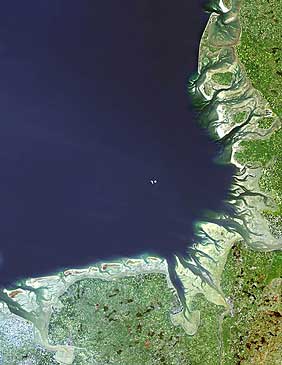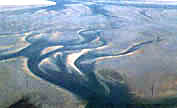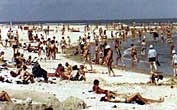Wadden Sea | |
|
The Wadden Sea is an excellent example of a coastal wetland. It is the largest unbroken stretch of intertidal mudflats in the world, and the perfect example of a coastal wetland with high biological, hydrological and ecological importance, shared between three countries, Germany, the Netherlands, and Holland. The Wadden Sea, an estuary of the North Sea, has a total area of about 8000 square km (3088 square miles). It is the world's biggest coherent habitat of its kind and one of the last unspoiled estuaries in Europe. There are many varied and extensive habitats in the Wadden Sea. This important estuary includes the salt marshes along the coast line as well as the islands and dunes. The mud flats consist of the areas which get flooded twice a day and then fall dry again, and of the channel system of tideways, channels and shipping channels between the islands, which are responsible for the flooding and for the draining. The mud flats are known for their very low inclination which is usually less than 1 m (1.094 yards) of difference in altitude on a 1000 m (0.621 miles) long stretch. The water of the Wadden Sea has a salinity of 25 ppt to 30 ppt on an annual average. However, climatic factors can cause dramatic changes in the salinity. At low tide a powerful rain can dilute the residual water that is collected in small puddles, so the salt content can drop down to 10 ppt. The area supports rare plant and animal species. The area is of international importance as staging, wintering, moulting, and foraging areas for many bird species. The millions of birds that migrate from their breeding grounds in the arctic areas of Siberia, Greenland and North America to the wintering grounds in Europe and Africa and back again, pass through the Wadden Sea and stay for a short or longer period to feed, rest and moult. The Wadden Sea makes it possible for these birds to build up the necessary food reserves to enable them to continue on their migration route for many thousands of kilometers. In total, the entire Wadden Sea hosts an average of 10 million birds spread over the year. This estuary is also of vital importance for the reproduction and life cycle of several fish species. Human uses of this valuable estuary include military activities, gas exploitation, fishing, and water sports. Tourism is also an important activity in the region. There are two seal nursery tourist centers. However, most of the reserves within the site have strictly controlled public access. Other areas are already seasonally or permanently closed to public access so that seals and foraging shorebirds are not disturbed. The three Wadden Sea States have co-operated to protect the Wadden Sea since the 1970s. In 1982 they signed the "Joint Declaration on the Protection of the Wadden Sea" which is the basis for the trilateral co-operation. A tri-lateral Wadden Sea Plan was jointly approved by the governments in 1997. The Wadden Sea is one of the rarest relatively undisturbed estuarine systems in Europe. Its unique character, enormous importance for keeping intact habitats of vast amounts of biological species, and fascinating landscape has led to considerable research and management efforts on national, as well as international levels, in order to prevent the development of irreversable environmental changes as a result of human impact. The area is affected by recreational activities, military use and pollution from pesticides and waste water, particularly from the River Rhine. Plans for gas and oil exploration and the development of Emden Harbour (Germany) may threaten the site.
|
 (Courtesy of Institute for Coastal Research http://coast.gkss.de)   |